Key takeaways:
- Component-driven development enhances code maintainability and fosters team autonomy through reusable, independent components.
- Key principles include modularity, reusability, and thorough documentation, which improve collaboration and streamline onboarding.
- Tools like React, Vue, and Storybook facilitate the creation and management of components, enhancing development speed and design consistency.
- Future trends suggest increased collaboration and the integration of AI to optimize component development and improve design processes.
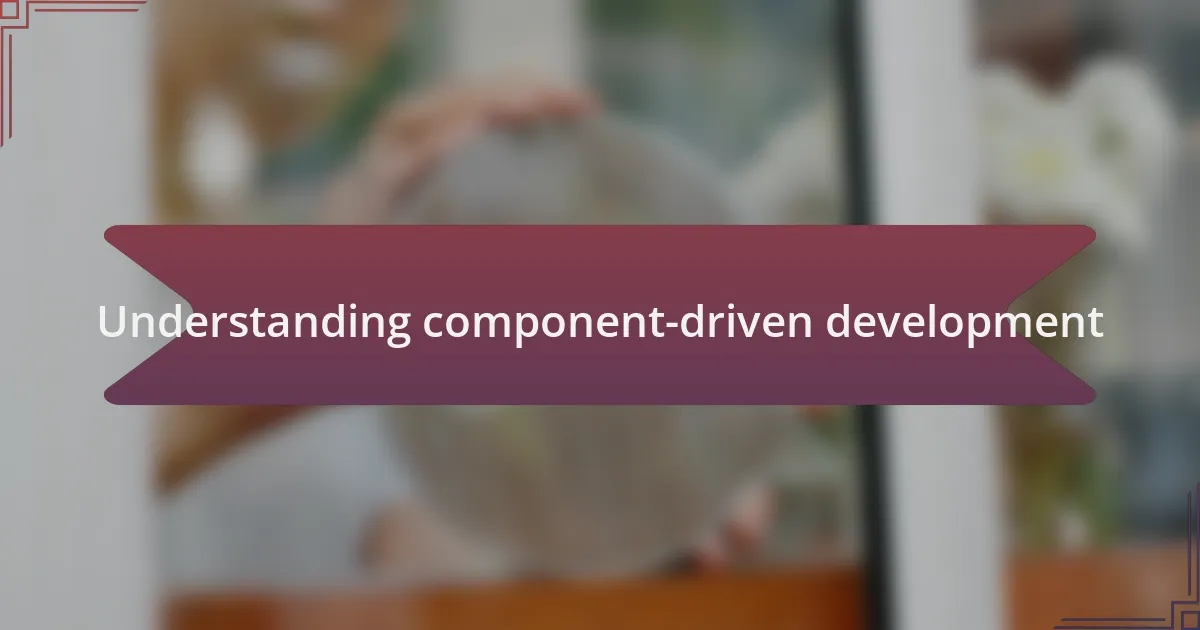
Understanding component-driven development
Component-driven development is an approach that emphasizes building software through reusable components, which makes a lot of sense to me. I remember diving into a project where I created a navigation component that could be used across multiple pages. It was liberating to realize how much time I saved by not having to reinvent the wheel every time I needed a menu.
Have you ever felt overwhelmed by the amount of code you need to maintain? That’s where the beauty of component-driven development shines. Each component can be developed, tested, and updated independently. This encapsulation not only improves code maintainability but also fosters a sense of autonomy within the development team. I’ve found that when teams adopt this mindset, it leads to a more agile and responsive development process.
In essence, understanding component-driven development is about recognizing the power and flexibility that comes from modular design. I often reflect on how this approach transforms our workflow, allowing for greater collaboration and innovation. It feels like we’re not just coding; we’re building a cohesive ecosystem that can easily evolve with our users’ needs. What about you? Have you noticed the same shift in your projects?
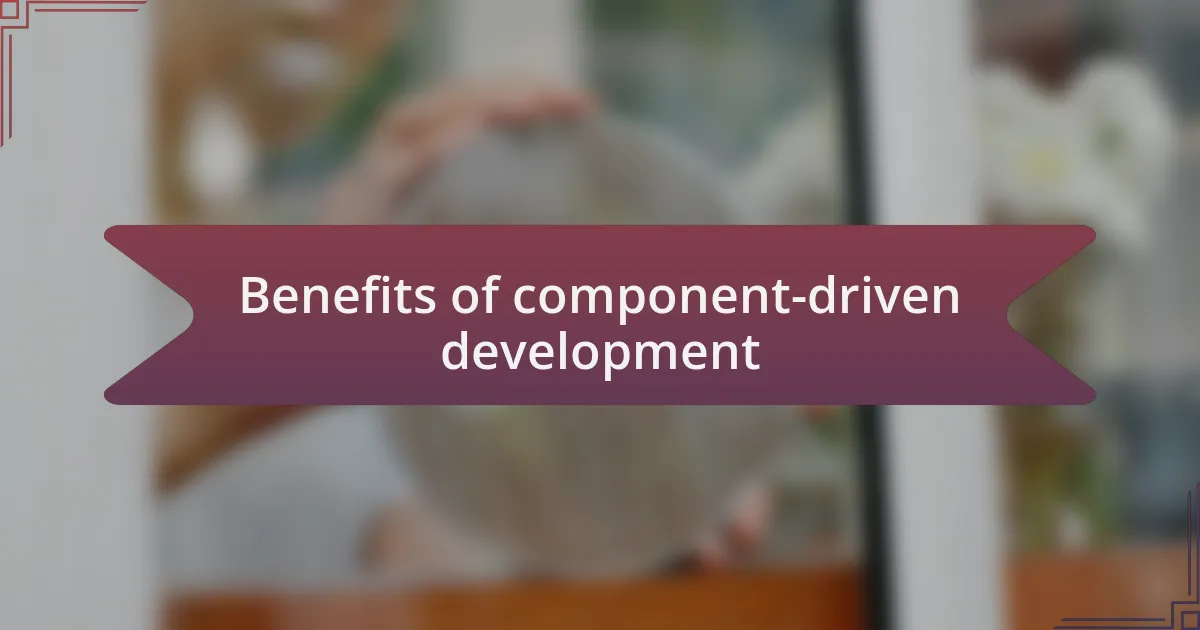
Benefits of component-driven development
One significant benefit of component-driven development is the enhanced consistency it brings to user interfaces. I remember a project where I had to ensure the design was uniform across several different pages. By using shared components, achieving that visual harmony was a breeze. It’s like having a set of building blocks; you can create diverse structures without losing your original design intent. Have you ever struggled to align styles across a project? This approach effortlessly avoids those pitfalls.
Another advantage I’ve experienced is the speed of development. Instead of coding each part from scratch, I could simply assemble existing components like a puzzle. In a recent sprint, this approach allowed my team to implement new features in record time. It was thrilling to see how quickly we could respond to user feedback. Isn’t it exciting to move fast while knowing you’re building on a solid foundation?
Moreover, the collaborative atmosphere that component-driven development fosters is something I truly value. I recall a time when developers and designers worked closely together, each contributing their expertise to refine components. This collaboration not only enriched our work but also led to more innovative solutions. Can you remember a time when collaboration took your project to new heights? It’s those moments that make the hard work worthwhile.
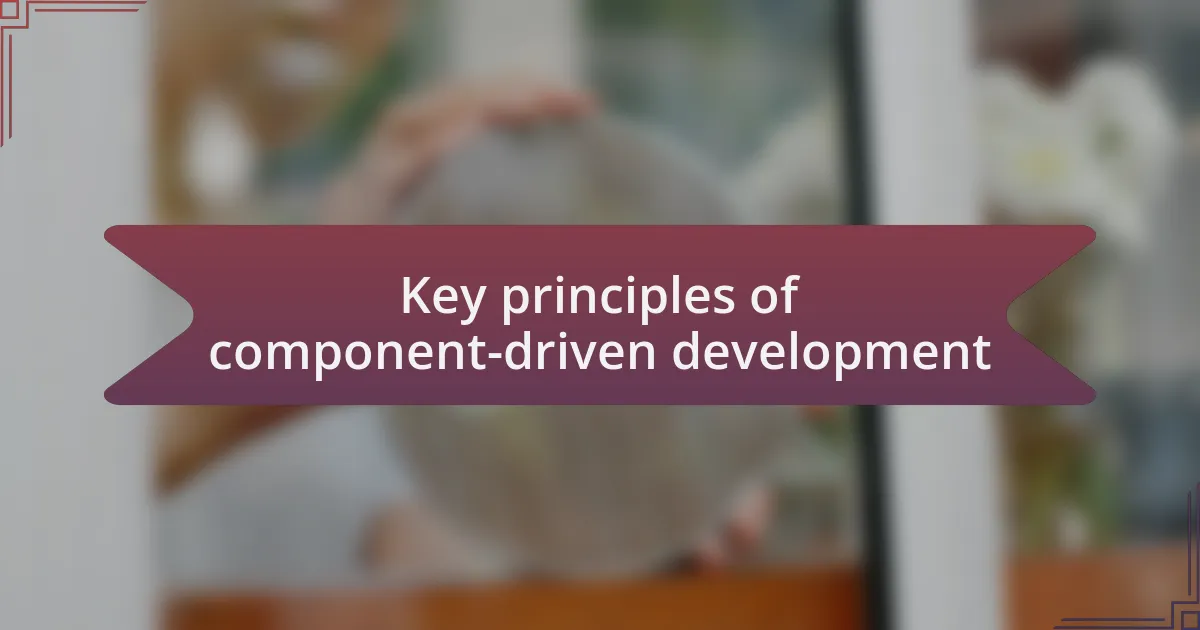
Key principles of component-driven development
When I think about the key principles of component-driven development, one that stands out is modularity. The idea is to break down a large application into smaller, independent components, much like how we tackle large tasks by dividing them into manageable chunks. I remember a time when I was overwhelmed by the complexity of a web app. By restructuring it into clear, self-contained components, not only did the code become easier to manage, but I also felt a sense of accomplishment with every tiny module I completed.
Another principle is reusability. This concept resonates deeply with me; who wouldn’t want to maximize their efforts? I once developed a button component that was reused across multiple projects. Each time I dropped it into a new application, I felt relief knowing I didn’t have to reinvent the wheel. Have you ever felt satisfaction from reusing a solution? This efficiency not only saves time but also maintains consistency throughout different applications.
Lastly, documentation plays an essential role in component-driven development. I’ve learned that well-documented components can significantly ease collaboration and onboarding. In one project, my team was able to onboard a new member quickly because they could refer to the clear documentation of each component. Isn’t it amazing how effective communication can bridge knowledge gaps? By focusing on thorough documentation, you equip your team with the tools they need to succeed collaboratively.
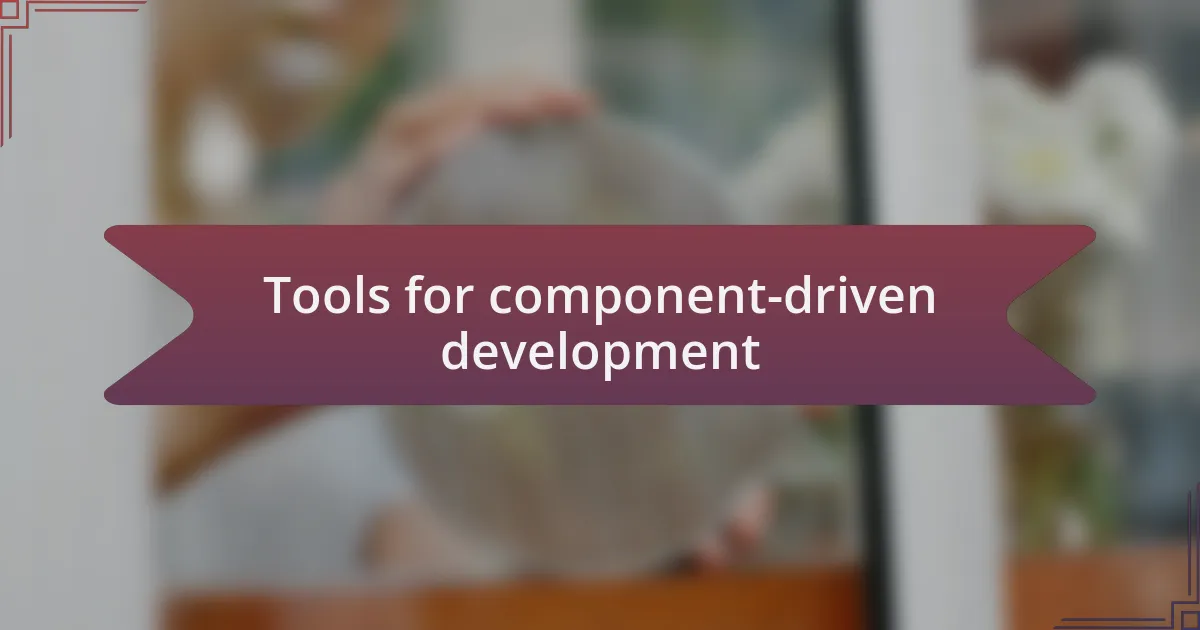
Tools for component-driven development
When it comes to tools for component-driven development, I find that libraries like React and Vue are game-changers. These frameworks allow developers to build user interfaces with reusable components, which makes my job so much smoother. I remember diving into a new React project, and the way I could create a component library at my fingertips transformed how I managed the entire codebase. Have you experienced a similar sense of ease with these tools?
Another essential player in this arena is Storybook. I appreciate how it enables developers to visualize the components in isolation, making it easier to spot inconsistencies and design flaws before they hit production. One time, while working on a complex UI, we used Storybook for component testing, and its visual aid helped my team refine our designs significantly. Isn’t it reassuring to see your components come to life and interact seamlessly?
Additionally, tools like Bit help you share and collaborate on components across different projects. I remember integrating Bit into my workflow, and it felt liberating to manage and update components shared among teams effortlessly. It’s remarkable how such tools can foster collaboration and innovation. Have you found any tools that have made a significant impact on your component-driven development process?

My experiences with component-driven development
When I first embraced component-driven development, I was amazed by how it shifted my approach to coding. Each component felt like a building block, allowing me to construct complex interfaces without the overwhelming clutter of traditional development. I recall the thrill of breaking down a massive web application into manageable parts; it was like solving a puzzle where each piece clicked into place perfectly.
I distinctly remember a project where I implemented a shared component library. As I collaborated with my team, it became clear that we were not just writing code—we were creating a cohesive experience. The joy of seamlessly updating a single component and seeing those changes reflected across multiple pages in real-time was incredibly satisfying. Have you ever felt that sense of collective achievement when a shared vision comes to life?
Moreover, my experiences with component-driven architecture have taught me the value of consistency in design. There was a time when I neglected design patterns, and it led to a disjointed user experience. Once I adopted a component-focused mindset, I noticed how important it was to ensure that each component not only functioned well on its own but also harmonized with the overall aesthetic of the application. This transformation not only improved our design process but also fostered a culture of attention to detail within my team. How has your focus on components shaped the way you approach design and development?
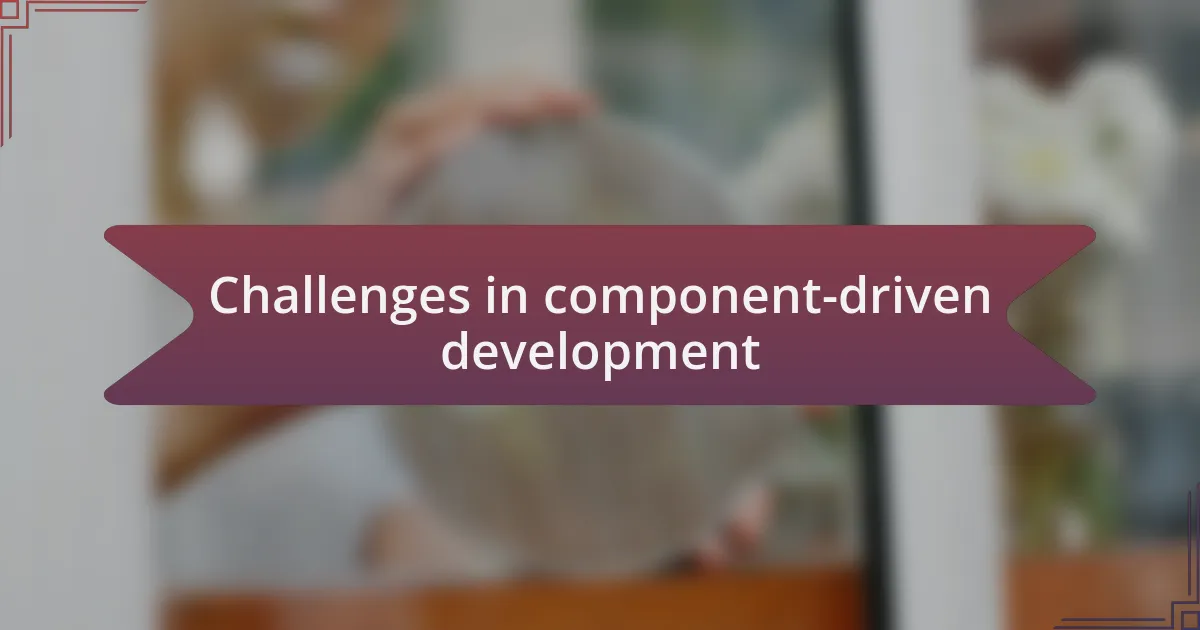
Challenges in component-driven development
One of the most significant challenges I’ve faced with component-driven development is managing state across various components. In my earlier projects, I underestimated the complexity that state management could introduce. I found myself tangled in a web of props and callbacks, which sometimes felt more like an exercise in frustration than a streamlined process. Have you ever been caught in a situation where a simple change spiraled into a complicated maze?
Another hurdle that surfaced was ensuring consistent documentation of components. Initially, I thought of documentation as an afterthought. This led to confusion among team members trying to use or modify components. I learned the hard way that investing time in detailed documentation upfront ultimately saves a lot of time and energy. Isn’t it frustrating when you realize that what could have been a straightforward fix turns into a scavenger hunt for information?
Lastly, I discovered that component reusability could often fall victim to customization needs. I recall a project where components became too tailored to specific use cases, losing their original purpose. This made integration with future projects cumbersome. It made me question: how do we strike the right balance between customization and the flexibility that promotes reusability?
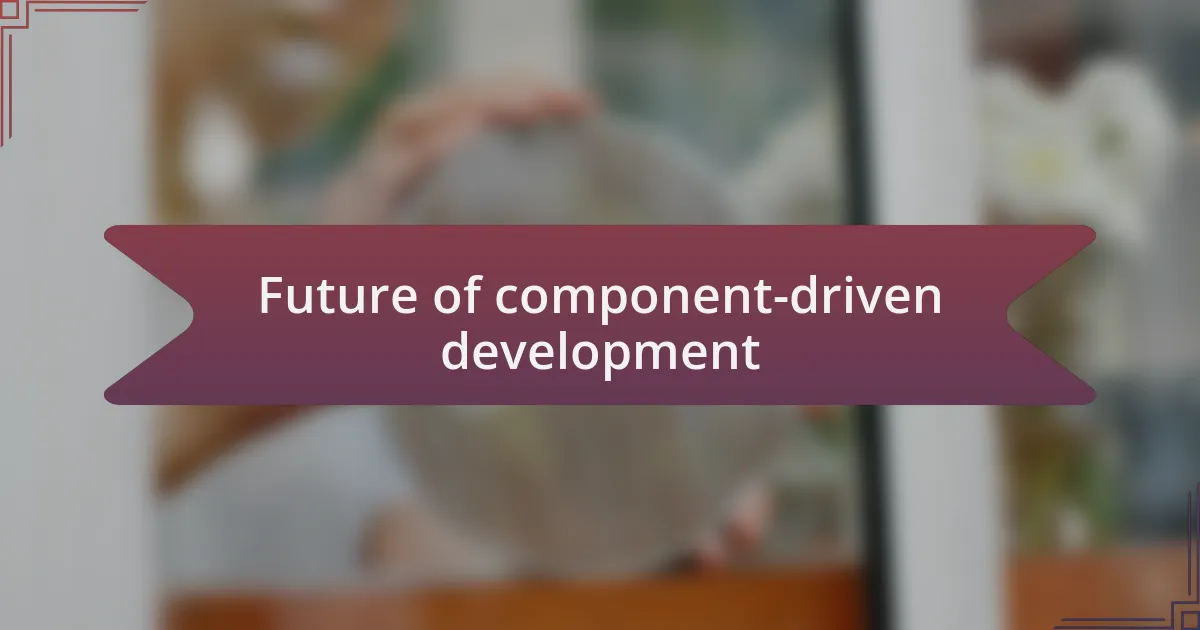
Future of component-driven development
The future of component-driven development is promising, largely due to the rapid evolution of design systems and frameworks. I can’t help but feel excited when I think about how tools like React and Vue.js are continually improving, allowing for even more seamless component integration. Will we see a future where developing entire applications feels as easy as piecing together LEGO blocks? I truly believe we might be close.
As I look ahead, I perceive a significant shift toward increased collaboration among teams. I remember a time when silos within teams led to inconsistencies in component design and functionality. However, with the rise of component libraries that everyone can access, teams are beginning to unify their approach. Imagine a scenario where designers, developers, and stakeholders work hand-in-hand from the get-go—wouldn’t that change the entire landscape of development?
Moreover, I foresee artificial intelligence and machine learning playing a role in optimizing component development. For instance, I’ve often hit a wall trying to decide the best design patterns for a new component. What if AI could analyze patterns in our past projects and suggest optimal solutions? This potential feels like it’s just around the corner, and I believe it will not only save time but also enhance creativity by letting us focus on more innovative aspects of our work.